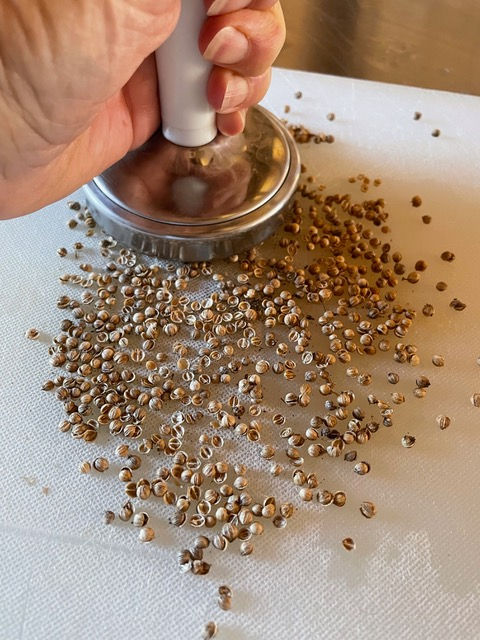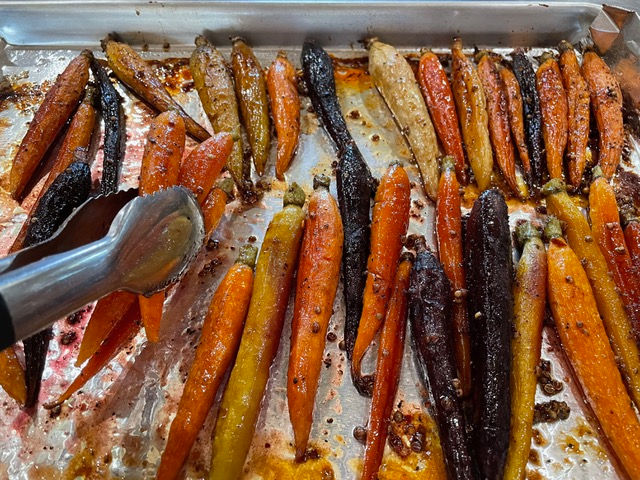To Bee or Not To Bee
- andreasachs1
- Nov 22, 2021
- 4 min read
Updated: Dec 8, 2021
By Bonnie Fishman / San Francisco Bay Area

There’s one thing I know for sure: I don’t want to be a queen bee. I always thought that would be kind of a nice position to be in. Everyone feeding you, waiting at your beck and call. But during my recent visit to an authentic beekeeper’s domain I learned otherwise. Yes, the queen is put on a pedestal. Does she get to rest on her laurels and soak up the adulation? Heck no! That queen works harder than all the other bees. Here’s the kicker: if she slacks off, the other bees kill her. Thanks a lot! The queen has laid every egg in the hive and that’s how the colony pays her back.
Recently, I had the pleasure of visiting the hives of Madelyn and Julianna Mancini, mother and daughter, third-generation beekeepers in San Martin, Calif. They have two stacks of hives in their large backyard. I have wanted to see a bee operation for years and never had the opportunity to suit up to get up close and personal. The two women generously invited me over to see what it’s all about.

In prepping for my visit, I soon learned that the amount of research that has been done on bees is vast. It has focused particularly on their importance to our food chain and the fact that bees are dying out in mass quantities, threatening our continued food source, hence, the human race. According to the USDA, “pollinators, most often honey bees,are responsible for one in every three bites of food we take.”
Think about it. That is a staggering statistic, especially because the bee population has been declining in this country for 30 years. “Without bees to pollinate crops,” warned Business Insider in August, 2019., “yields on about 35 percent of agricultural land worldwide would suffer, and 87 of the world's leading food crops would be affected.” In short, the worldwide bee population is declining because of habitat loss, climate change, pollution, and disease.

This is clearly a doomsday situation. What can we do right now as everyday citizens? For one, stop using bee-killing pesticides. Plant pollinator plants and trees. “Host” bees with natural or manmade hives. Support your local beekeepers to help keep their bee colonies viable and strong. Bees not only make honey but produce beeswax. Buy these products at your farmer’s markets.
My visit to Madelyn and Julianna’s beehives was filled with on-the-spot lessons about both the physical structure of the bee boxes and the hierarchy of the hives. I learned that there are three types of bees: the queen, the worker bees (all non-reproducing females) and drones (males who mate with the queen). The queen bee has attendants who feed her and keep her clean. The other workers act as nursemaids to the larva, forage for flower nectar, and clean the hive. The bees live on their own honey. When the beekeepers harvest the honey, usually in September and October, they leave enough for the bees to feed themselves with until the next season, when the flowers are again in bloom and more honey is produced.

What I enjoyed most about my visit was their captivating enthusiasm for beekeeping. They are quite caring and protective of the whole operation. Madelyn says that they produce about 60 pounds of honey a year, which they give away or sell to neighbors and friends. I love that she calls the bees “friendly--they’re Italian bees, ma certo” (but of course)!
Honey has so many uses in everyday cooking. We find it in all kinds of desserts, used for both the flavor and as a sugar substitute. Those who don’t eat refined sugar use honey as their go-to sweetener, even adding it to yogurt, ice cream, oatmeal and baked goods. I also enjoy using it in marinades, salad dressings, and glazes for meats and vegetables.

Today’s recipe is a glaze for carrots, one of the most classic pairings. Who doesn’t love honeyed carrots? Since honey is so sweet, there are three ingredients that allow the honey flavor to come through but cut the sweetness: salt, acid, and spice. In this case, I use kosher salt, lemon juice, and crushed red pepper flakes.
Cumin-Scented Honey Carrots With Coriander Seeds
Yield: 8 servings

Glaze:
1/3 c. honey
1/4 c. extra virgin olive oil
2 Tbs. lemon juice
1 Tbs. toasted coriander seeds, crushed with a mallet
1 tsp. ground cumin
1 tsp. kosher salt
1/2 tsp. ground coriander
1/4 tsp. crushed red pepper flakes
Carrots:
2 lb. petite rainbow carrots or rainbow carrots, peeled, cut in half
1 tsp. kosher salt
1/4 tsp. fresh ground black pepper
Combine the glaze ingredients in the bottom of a 2-quart rectangular casserole. Mix thoroughly. Allow to sit at room temperature for about 30 minutes.
Preheat oven to 400°. Line a large jelly roll pan with foil. Brush with oil or spray with pan release.
Toss the carrots, one pound at a time in the glaze. Lay the carrots on the prepared pan. Continue with remaining carrots. Scrape up the glaze from the casserole and scatter it over the tops of the vegetables. Sprinkle with salt and pepper. Roast for 20 minutes, stirring them with a pair of tongs. Continue cooking for another 15-20 minutes until the carrots are tender.
Arrange the carrots on a serving platter, scraping the glaze from the roasting pan onto the top of the vegetables. Serve hot or at room temperature.





Bonnie Fishman attended the Cordon Bleu Cookery School in London. Later, she owned and operated Bonnie’s Patisserie in Southfield, Mich. and Bonnie’s Kitchen and Catering in Bloomfield Hills, Mich. She has taught cooking for over 35 years and created hundreds of recipes. She is now living in Northern California.
Nonnative honeybees threaten native bumblebees.
https://biologicaldiversity.org/w/news/press-releases/american-bumblebee-takes-step-toward-endangered-species-act-protection-2021-09-28/
Plant native plants for bumblebees, see CA native plant society for suggestions.